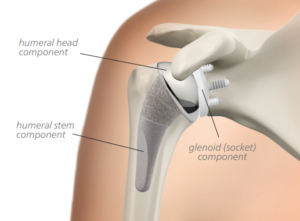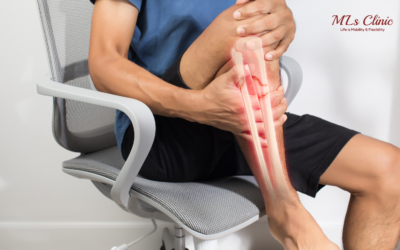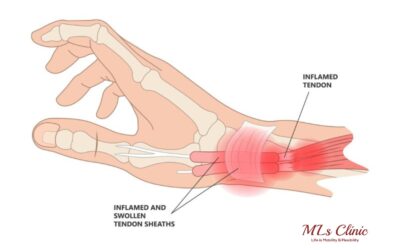From Ache To Ease: The Ultimate Guide To Shoulder Arthritis Treatments And Surgery

Shoulder arthritis is when your shoulder joint becomes inflamed. Over time, this causes the cartilage to wear away. Symptoms include pain, stiffness, reduced movement, and noises like popping or grinding in the joint. Treatments can vary from home remedies like ice, heat, and exercises to more serious options like surgery.
Overview
What is Shoulder Arthritis?
Shoulder arthritis is when the cartilage inside the shoulder joint gets damaged. The shoulder has two joints, but arthritis usually affects the larger ball-and-socket joint called the glenohumeral joint, which connects the glenoid and humerus bones. This cartilage covers both the ball (humeral head) and the socket (glenoid).
When the cartilage in the shoulder starts to wear away on the surface and deeper layers, it’s called shoulder arthritis. The other joint in the shoulder, the acromioclavicular (AC) joint, can also develop arthritis, known as AC joint arthritis.
Symptoms & Causes
Symptoms
What Are the Signs and Symptoms of Shoulder Arthritis?
Shoulder arthritis symptoms can vary, but common signs include:
- Pain in the Shoulder Joint: This is the most common symptom. You might first notice pain during activities, but as the condition progresses, you might feel pain at any time, even
 without moving your arm. The pain may worsen when lifting heavy objects or after exercise and might spread down your arm to your elbow or wrist if severe.
without moving your arm. The pain may worsen when lifting heavy objects or after exercise and might spread down your arm to your elbow or wrist if severe. - Stiffness and Loss of Motion: You might experience stiffness and reduced movement in your shoulder, making everyday tasks like dressing, bathing, driving, or housework challenging.
- Grinding, Clicking, or Popping Sounds: These noises occur due to cartilage loss, which makes the joint surface rough. They can happen with or without pain.
- Sleep Difficulties: Finding a comfortable sleeping position can be hard. Shoulder movement might cause pain. To ease discomfort, try placing a pillow under the elbow of the affected side if you sleep on your back, or consider sleeping in a recliner for relief.
Causes and Types of Shoulder Arthritis
There are several types of shoulder arthritis, each with different causes, and some causes are still unknown:
- Osteoarthritis: Also known as degenerative joint disease, osteoarthritis is often due to wear and tear from aging. It can affect other joints too and is the most common type of arthritis.
- Rheumatoid Arthritis: This is an autoimmune disorder where the body attacks its own healthy cells, including those in the joint lining. It can affect both shoulders simultaneously.
- Post-Traumatic Arthritis: This type develops after an injury to the shoulder, such as a fracture or dislocation.
- Rotator Cuff Tear Arthropathy: This arthritis can occur after a severe, long-lasting tear of the rotator cuff tendons. These tendons help keep the shoulder joint stable, and a tear can cause the joint to rub against bones, leading to arthritis.
- Avascular Necrosis: This condition happens when the blood supply to the shoulder’s ball (humeral head) is disrupted, causing the bone to die and collapse, which results in arthritis.
Diagnosis and Tests of Shoulder Arthritis
How is shoulder arthritis diagnosed?
Shoulder Arthritis
-
- X-Ray
- CT Scan
- MRI
Management and Treatment
How is shoulder arthritis treated?
Treatment options include home care, lifestyle changes, medications, and possibly surgery.
Home-Based and Lifestyle Care
Shoulder arthritis treatment usually starts with non-surgical, at-home care and lifestyle changes to keep your shoulder flexible and reduce pain. These include:
- Shoulder Exercises: Stretching exercises can help maintain or improve your range of motion. You might work with a physical therapist for this.
- Activity and Lifestyle Adjustments: Avoid or reduce activities that cause shoulder pain, such as lifting heavy objects or certain sports.
- Ice and Heat: Use ice or moist heat to reduce inflammation and relieve pain. For ice, apply a frozen cold pack or a bag of frozen peas to your shoulder for 20 minutes at a time, several times a day. Moist heat can help before stretching or whenever it makes you more comfortable.
Medications
Medications help ease pain and reduce inflammation. Common types include:
- Over-the-Counter Medications
- Injections
Shoulder Surgery
If other treatments don’t help and your arthritis is getting worse, surgery might be an option. Common surgeries include:
- Total Shoulder Replacement Surgery: Read More About Total Shoulder Replacement Surgery

- Reverse Total Shoulder Replacement Surgery: The ball and socket are switched. A metal ball is attached to the shoulder blade, and a socket is attached to the humerus. Read more about Reverse Total Shoulder Replacement.
- Arthroscopic Shoulder Debridement: Small tools and a camera are used through tiny cuts to remove damaged cartilage and bone spurs. This can provide pain relief for up to 24 months but doesn’t stop arthritis.
- Resection Arthroplasty: For arthritis in the acromioclavicular (AC) joint, a small piece of bone from the end of the collarbone is removed. Scar tissue then fills the gap between the collarbone and shoulder blade.
Prevention Of Shoulder Arthritis
Can shoulder arthritis be prevented?
You can lower your risk of developing arthritis by:
- Avoiding Tobacco Products: If you use tobacco, ask your healthcare provider for help quitting and information on support services.
- Doing Low-Impact Exercise: Engage in low-impact, non-weight-bearing activities to keep your shoulder healthy.
- Maintaining a Healthy Weight: Keep your body weight within a healthy range.
- Eating a Healthy Diet: Follow a balanced diet, such as the Mediterranean diet, to support overall health.
- Reducing Joint Injury Risk: Avoid or limit activities that might injure your shoulder.
- Seeing Your Healthcare Provider Early: If you notice symptoms, visit your provider early. Early diagnosis can help manage pain, adjust activities, and prevent further cartilage damage.
Conclusion:
Shoulder arthritis can be painful and impact your daily life. While there’s no cure, you can find relief through ice, heat, and exercises to keep your shoulder flexible and comfortable. Try to avoid activities that cause pain. If these methods don’t help, talk to your healthcare provider about possible surgeries. Contacting the doctor is the first step to figuring out what’s causing your shoulder pain and creating a treatment plan to relieve your symptoms.






